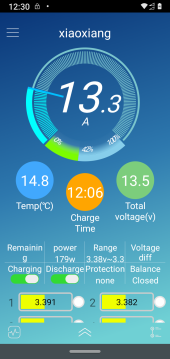mystic pizza
New Member
- Joined
- Jun 20, 2021
- Messages
- 134
I have lifep04 cells connected as a 12V bank separated by a switch connected to a 12 V lead acid battery bank.
The system is currently set to only charge from solar cells (4 x 250W) in a 2x2 array fed into 2 separate 30A mppt charge controllers.
I have set each controller to have a boost voltage of 13.8V, duration 30 minutes, a float voltage of 13.4 V and a boost reconnect of 13.3V.
As I understand it, that should mean the banks should charge until a voltage of 13.8 V is reached and held for 30 minutes before dropping to a float voltage of 13.4V. When the voltage then falls to, or perhaps below 13.3V the system charges again until the boost voltage of 13.8V is reached,which as I understand it, should mean the lifep04 bank is at 99%capacity.
What appears to happen though is the controllers go into float before the batteries reach 13.8V,and the MT50 meter connected to the controller shows 0.2V higher than the battery voltage.
Why is it going to float too early?
Do my settings sound reasonable?
What can I do to stop one mppt controller floating too soon? As far as I know they cannot be connected to 'talk' to each other.
Thanks
The system is currently set to only charge from solar cells (4 x 250W) in a 2x2 array fed into 2 separate 30A mppt charge controllers.
I have set each controller to have a boost voltage of 13.8V, duration 30 minutes, a float voltage of 13.4 V and a boost reconnect of 13.3V.
As I understand it, that should mean the banks should charge until a voltage of 13.8 V is reached and held for 30 minutes before dropping to a float voltage of 13.4V. When the voltage then falls to, or perhaps below 13.3V the system charges again until the boost voltage of 13.8V is reached,which as I understand it, should mean the lifep04 bank is at 99%capacity.
What appears to happen though is the controllers go into float before the batteries reach 13.8V,and the MT50 meter connected to the controller shows 0.2V higher than the battery voltage.
Why is it going to float too early?
Do my settings sound reasonable?
What can I do to stop one mppt controller floating too soon? As far as I know they cannot be connected to 'talk' to each other.
Thanks




